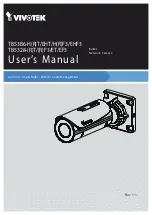3.0 Functional Description
(Continued)
13
www.national.com
DP83816
Little Endian (CFG:BEM=0):
The byte orientation for
receive and transmit data in system memory is as follows:
Big Endian (CFG:BEM=1):
The byte orientation for
receive and transmit data in system memory is as follows:
3.1.1.2 PCI Bus Interrupt Control
PCI bus interrupts for the DP83816 are asynchronously
performed by asserting pin INTAN. This pin is an open
drain output. The source of the interrupt can be determined
by reading the Interrupt Status Register (ISR). One or more
bits in the ISR will be set, denoting all currently pending
interrupts.
Caution:
Reading of the ISR clears ALL bits.
Masking of specified interrupts can be accomplished by
using the Interrupt Mask Register (IMR).
3.1.1.3 Timer
The Latency Timer described in CFGLAT:LAT defines the
minimum number of bus clocks that the device will hold the
bus. Once the device gains control of the bus and issues
FRAMEN, the Latency Timer will begin counting down. If
GNTN is de-asserted before the DP83816 has finished
with the bus, the device will maintain ownership of the bus
until the timer reaches zero (or has finished the bus
transfer). The timer is an 8-bit counter.
3.1.2 Tx MAC
This block implements the transmit portion of 802.3 Media
Access Control. The Tx MAC retrieves packet data from
the Tx Buffer Manager and sends it out through the
transmit portion. Additionally, the Tx MAC provides MIB
control information for transmit packets.
3.1.3 Rx MAC
This block implements the receive portion of 802.3 Media
Access Control. The Rx MAC retrieves packet data from
the receive portion and sends it to the Rx Buffer Manager.
Additionally, the Rx MAC provides MIB control information
and packet address data for the Rx Filter.
3.2 Buffer Management
The buffer management scheme used on the DP83816
allows quick, simple and efficient use of the frame buffer
memory. Frames are saved in similar formats for both
transmit and receive. The buffer management scheme also
uses separate buffers and descriptors for packet
information. This allows effective transfers of data from the
receive buffer to the transmit buffer by simply transferring
the descriptor from the receive queue to the transmit
queue.
The format of the descriptors allows the packets to be
saved in a number of configurations. A packet can be
stored in memory with a single descriptor per single packet,
or multiple descriptors per single packet. This flexibility
allows the user to configure the DP83816 to maximize
efficiency. Architecture of the specific system’s buffer
memory, as well as the nature of network traffic, will
determine the most suitable configuration of packet
descriptors and fragments. Refer to the Buffer
Management Section (Section 5.0) for more information.
3.2.1 Tx Buffer Manager
This block DMAs packet data from PCI memory space and
places it in the 2 KB transmit FIFO, and pulls data from the
FIFO to send to the Tx MAC. Multiple packets (4) may be
present in the FIFO, allowing packets to be transmitted with
minimum interframe gap. The way in which the FIFO is
emptied and filled is controlled by the FIFO threshold
values in the TXCFG register: FLTH (Tx Fill Threshold) and
DRTH (Tx Drain Threshold). These values determine how
full or empty the FIFO must be before the device requests
the bus. Additionally, once the DP83816 requests the bus,
it will attempt to empty or fill the FIFO as allowed by the
MXDMA setting in the TXCFG register.
3.2.2 Rx Buffer Manager
This block retrieves packet data from the Rx MAC and
places it in the 2 KB receive data FIFO, and pulls data from
the FIFO for DMA to PCI memory space. The Rx Buffer
Manager maintains a status FIFO, allowing up to 4 packets
to reside in the FIFO at once. Similar to the transmit FIFO,
the receive FIFO is controlled by the FIFO threshold value
in the RXCFG register: DRTH (Rx Drain Threshold). This
value determines the number of long words written into the
FIFO from the MAC unit before a DMA request for system
memory access occurs. Once the DP83816 gets the bus, it
will continue to transfer the long words from the FIFO until
the data in the FIFO is less than one long word, or has
reached the end of the packet, or the max DMA burst size
is reached (RXCFG:MXDMA).
3.2.3 Packet Recognition
The Receive packet filter and recognition logic allows
software to control which packets are accepted based on
destination address and packet type. Address recognition
logic includes support for broadcast, multicast hash, and
unicast addresses. The packet recognition logic includes
support for WOL, Pause, and programmable pattern
recognition.
The standard 802.3 Ethernet packet consists of the
following fields: Preamble (PA), Start of Frame Delimiter
(SFD), Destination Address (DA), Source Address (SA),
Length (LEN), Data and Frame Check Sequence (FCS). All
fields are fixed length except for the data field. During
reception, the PA, SFD and FCS are stripped. During
transmission, the DP83816 generates and appends the
PA, SFD and FCS.
Byte 0
Byte 1
Byte 2
Byte 3
0
7
8
15
16
23
24
31
LSB
C/BE[0]
C/BE[1]
C/BE[2]
C/BE[3]
MSB
Byte 3
Byte 2
Byte 1
Byte 0
0
7
8
15
16
23
24
31
MSB
C/BE[0]
C/BE[1]
C/BE[2]
C/BE[3]
LSB
Summary of Contents for MacPHYTER-II DP83816
Page 106: ...105 www national com DP83816 Notes...


















